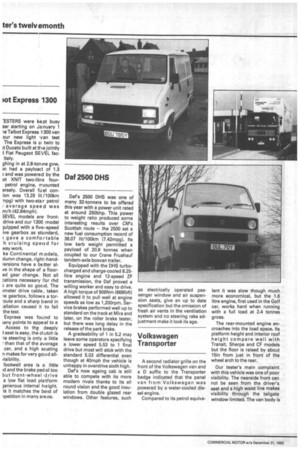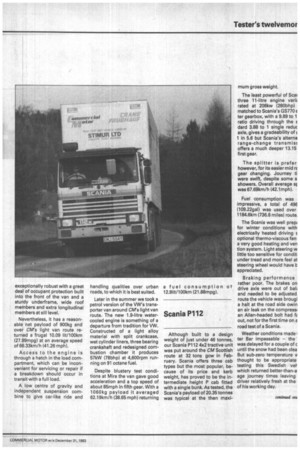Volkswagen Transporter
Page 24

Page 25

If you've noticed an error in this article please click here to report it so we can fix it.
A second radiator grille on the front of the Volkswagen van and a D suffix to the Transporter badge indicated that the panel van from Volkswagen was powered by a water-cooled diesel engine.
Compared to its petrol equiva
lent it was slow though much more economical, but the 1.6 litre engine, first used in the Golf car, works hard when running with a full load at 2.4 tonnes gross.
The rear-mounted engine encroaches into the load space. Its platform height and interior roof height compare well with Transit, Sherpa and CF models but the floor is raised by about 15in from just in front of the wheel arch to the rear.
Our tester's main complaint with this vehicle was one of poor visibility. The nearside front can not be seen from the driver's seat and a high waist line makes visibility through the tailgate window limited. The van body is exceptionally robust with a great deal of occupant protection built into the front of the van and a sturdy underframe, wide roof members and extra longitudinal members at sill level.
Nevertheless, it has a reasonable net payload of 900kg and over CM's light van route returned a frugal 10.09 lit/100km (27.99mpg) at an average speed of 66.33km/h (41.26 mph).
Access to the engine is through a hatch in the load compartment, which can be inconvenient for servicing or repair if a breakdown should occur in transit with a full load.
A low centre of gravity and independent suspension combine to give car-like ride and handling qualities over urban roads, to which it is best suited.
Later in the summer we took a petrol version of the VW's transporter van around CM's light van route. The new 1.9-litre watercooled engine is something of a departure from tradition for VW. Constructed of a light alloy material with split crankcase, wet cylinder liners, three bearing crankshaft and redesigned combustion chamber it produces 57kW (78bhp) at 4,600rpm running on 91 octane fuel.
Despite blustery test conditions at Mira the van gave good acceleration and a top speed of about 85mph in fifth gear. With a 1060kg payload it averaged 62.19km/h (38.65 mph) returning a fuel consumption of 12.91it/100km (21.88mpg).
































































